BURLINGTON, ON October 23, 2012 It was a good crowd. As many, if not more, than the 600 that showed up December 2010 when the Region was advised that the province wanted some arrows placed on the Region’s Official Plan to show where a possible highway through the Escarpment might go.
That was the first anyone had heard about an actual location for any road being built across the Escarpment. There was an arrow placed on a map way back in 2002 that crossed Guelph Line north of Dundas Street and south of No. 1 Side road, bringing a potential highway down a more gentle (and less populated) slope of the escarpment.
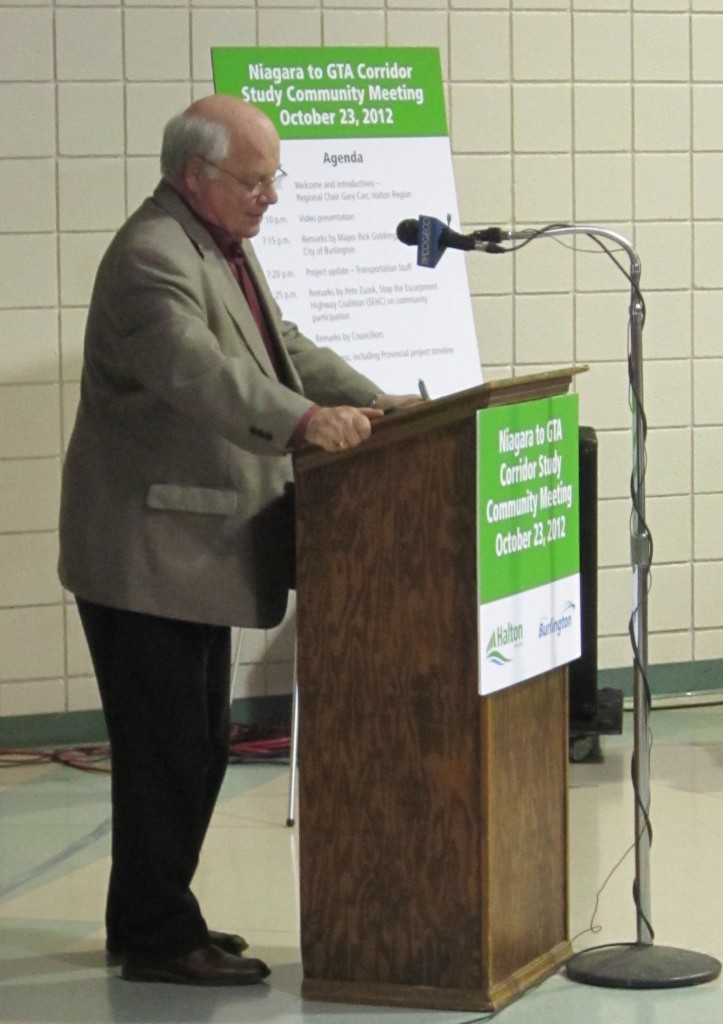
Councillor John Taylor, war horse on Escarpment issues got a round of applause before he said a word at the community meeting, held to voice once again Burlington’s opposition to a highway through any part of the Escarpment.
John Taylor, the politician who has been fighting any highway for longer than anyone else, took the standing room only audience back 40 years when the battle we are fighting today began. Twenty years ago it was the 403; in the 90’s it was the 407. That allowed the creation of Alton, a community of 10,000 people. Now they want another road that eats into the Escarpment – and we have to tell them that just is not on.
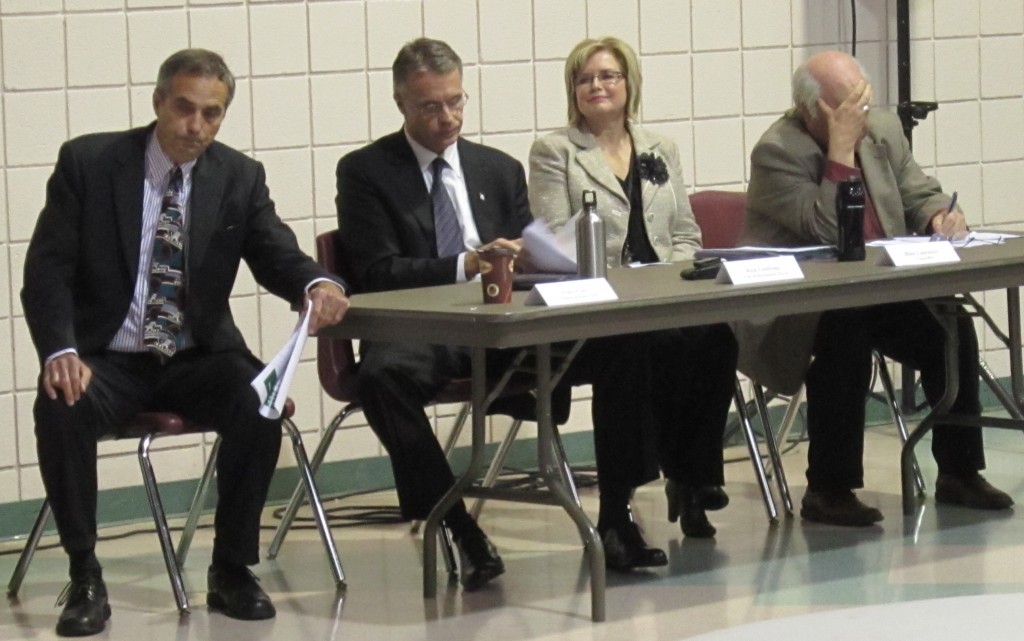
Regional Chair Gary Carr, Burlington Mayor Rick Goldring and Councillors Blair Lancaster and John Taylor all spoke to an audience of more than 600 people at the Mainway Recreation centre – on an evening when it rained.
When the event at the Mainway Recreational Centre was planned Burlington Mayor Rick Goldring and Regional Chair Gary Carr had an appointment with the Minister of Transportation (MTO) to impress upon him just how opposed both the Region and most particularly Burlington was to any kind of highway going through the Flamborough – Burlington part of the province.
At that time, just over six weeks ago, the government was keeping everyone in the Legislature to fight off any sudden vote that would bring down the minority Liberal government. The meeting kept being put off. Then the Premier resigns and all the rules change.
The Minister of Transportation was supposed to see Carr and Goldring on Monday, but that got pushed back to Thursday. One keeps wondering why these meetings keep getting pushed back.
Assuming Carr and Goldring meet with Bob Chiarelli, Minister of Transportation, they will be able to point to a room that was packed with people, every seat taken and all the walls lined with people standing as well as a couple sitting on the floor at the front of the room.
If what people think and feel matters – this was a crowd that politicians have to pay some attention to.
Gary Carr, Regional Chair spoke and then played a 5 minute video that is on the Regional web site.
Burlington Mayor Rick Goldring spoke.
Director of Transportation Services for Burlington, Bruce Zvaniga spoke and laid out the issues from a transportation perspective.
Pete Zuzek, spokesperson for Stop Escarpment Highway Coalition, gave the strongest presentation of the evening.
Burlington’s Ward 6 Councillor Blair Lancaster spoke.
John Taylor, Councillor for Ward 3 rose to speak to a great round of applause and provided some of the history that went back 40 years. This is indeed a long fight.
Ted Chudleigh, provincial PC member for Halton spoke – forcefully one might add with not a word of notes.
Jane McKenna, provincial PC member for Burlington spoke, read from notes and released her correspondence to the Minister of Transportation.
While Tim Hudak, leader of the PC opposition at Queen’s Park is on record as being FOR a highway because he believes the issue is about jobs – both Chudleigh and McKenna were very clear that they were opposed to any highway going through Burlington. Would that opposition still be evident if a vote that could bring down the minority Liberal government was being held.
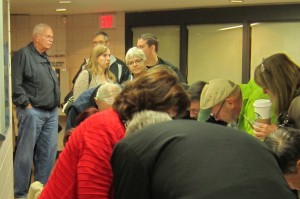
They hunched over tables as they signed the petition opposing any kind of road through the Escarpment.
Zvaniga set out where the province is in their deliberations. He laid out what had been done, when it was done, why it was done and what the next steps are going to be. Zvaniga had to give the technical overview because the province declined to send anyone to the meeting.
The MOT people have a job to do, part of which is to advise the government on what future transportation needs are likely to be. Part of the problem with this approach was brought to light when former Minister of Transportation, Kathleen Wynne explained to the Mayor of Burlington, during the last provincial election, that transportation engineers and planners don’t know how to think beyond the car and highways. At the time she said the province has one of the best highway building departments in the country – and that was the problem – they don’t know how to think outside that highway box. Which is a point the SEHC people are trying very hard to get across to the public.
There are more people on the roads and there will always be more people on the roads if we keep building roads. I had occasion to be at Pearson airport on Monday to pick up my wife returning from a visit with her Mother in Denmark. The flight was due at 3:00 pm, which I knew meant fighting rush hour traffic. It turned out to be a pretty quick trip – because we were able to use the HOV lane. There were very few cars in that HOV lane, but there were three lanes plugged solid on our right, bumper to bumper, with a single passenger in the car.
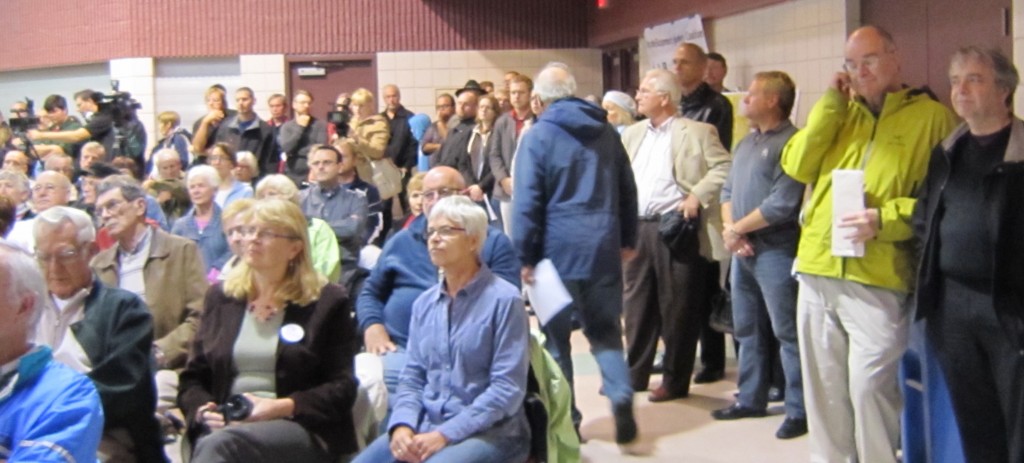
None of these people want to sit in their cars with bumper to bumper traffic on the QEW. But of the 600 people in the room less than ten took the bus to the meeting.
Why anyone would sit in that traffic, when they could be in a faster lane was something I couldn’t understand. Of course they needed an additional passenger in their car – why is that so hard to set up. Most of those people are driving to or from work, where there are surely people in their offices who live near them. Why are there not more people going on line to look for a person near them, that can share that drive? There is a smart phone app for people who want a lift (we used to call it hitch hiking) and are prepared to share the cost. It’s all done on line.
It was also pointed out that while rail isn’t being given the consideration it needs, a large part of that is because the federal government is not at the table. This is a provincial matter the government argues, while SEHC argues that it is a social matter and that we need to look at transportation issues at a much higher level and not focus on just what’s going on in Burlington.
SEHC believes people need to understand that we must look at transportation a lot differently and that we are going to have to get out of our cars. They point to global warming, the damage to the environment and the impact of commuting more than an hour to get to work and another hour to get home. Driving our cars is a habit we haven’t managed to break – and like smoking, it may eventually kill us.
Gary Carr finally got around to publicly thanking the people of PERL, Protect Escarpment and Rural Lands, for the hard fight they fought to win the Nelson Aggregate battle in North Burlington where Nelson had applied for a second aggregate mining permit. That application was denied – the first time anyone can remember such an application being turned down. It is perhaps a good omen. Carr, quite rightly, pointed out that were it not for organizations like PERL “we wouldn’t be this far without them”. Hopefully Carr will come through with some form of support for PERL – they are suffering from battle fatigue and they are hurting.
Carr pointed out that the Region has a population of 520,000 now and will have an expected 780,000 by 2031 and those people are going to have some way to get around. “This is a fight” declared Carr “that is going to last for decades. Fundamental changes are going to have to be made in the way we transport ourselves or a new highway will be needed. Somehow we have to get the cars off the road”.
But it is about more than just getting cars off the road; we have an agricultural economy in the Region and west into Flamborough.
Mayor Goldring pointed out again that the city has a 50/50 split between rural and urban settings and that any highway through the Escarpment will be the beginning of the end for the north Burlington we know today.
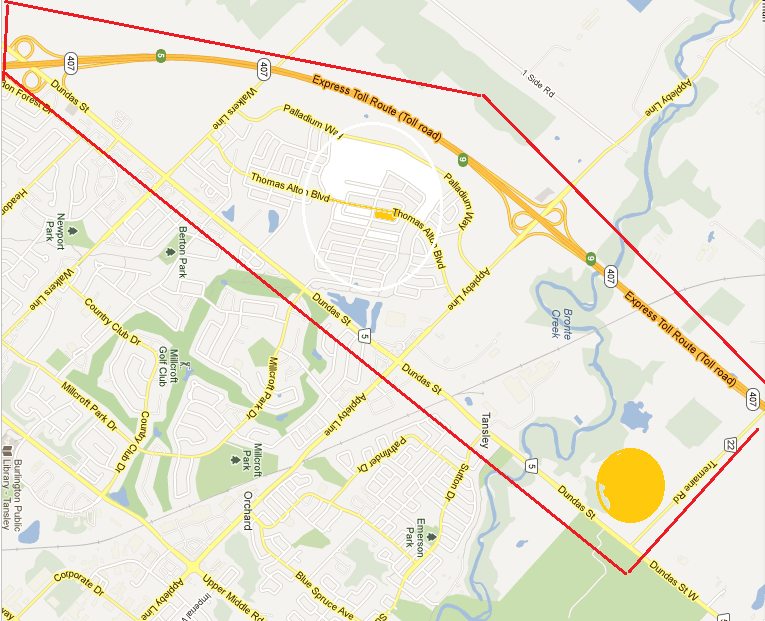
The land identified by the red borders was made available for development when the 407 highway was completed. The northern edge of developable land is south of the 407. Prior to 407 the boundary was Dundas – a highway through the Escarpment would move the rural-urban boundary even further north – as high as Lowville?
Taylor told of the Alton community that came into being when the 407was put through. The urban rural boundary used to be Dundas but the 407 created a piece of land that became available to developers and today we have a new community of 10,000 people.
GO got a solid mention – if the Lakeshore West line is electrified, that will result in GO trains every five minutes during peak travel times and every 20 minutes during the off peak. THAT kind of scheduling would take a lot of traffic off the QEW.
There were half a dozen speakers but they weren’t all politicians. Pete Zuzek, spokesperson for SEHC, the Stop Escarpment Highway Coalition, a group made up of 14 communities, grass roots level organizations with more than 15,000 members, gave a very clear presentation on what he felt was wrong with the approach the provincial government was taking to deciding if a highway was needed.
The Environmental Assessment is currently in Phase 1 – where they look at 1) Optimizing what we have, making better use of the roads we have; 2) expand the non- roads options; 3) widen the existing roads and 4) if none of those will provide the future means of getting around the MOT thinks we need – then look at new corridors.
One of those corridors would come though Burlington. It would swoop in at around Cedar Springs Road and drop down into that land on the North side of Dundas and joining up with the 407.
Pete Zuzek doesn’t want the province to get as far as that Phase 2. SEHC points out that building such a corridor will do very little for the traffic congestion down on the QEW.
What Pete Zuzek made clear was the immediate objective is to convince the MOT people that Phase 2 isn’t necessary – that there are more than enough sensible, environmentally sound options within the Phase 1 level.
The fear SEHC has is that should the province decide that Phase 2 is the direction to go in – then the planners and the engineers begin drawing lines on maps and thinking about expropriating property and the developers begin to plan for new housing developments. Some of the golf clubs along Walkers and Guelph Line will begin to get offers and before you know it – there goes the neighbourhood.
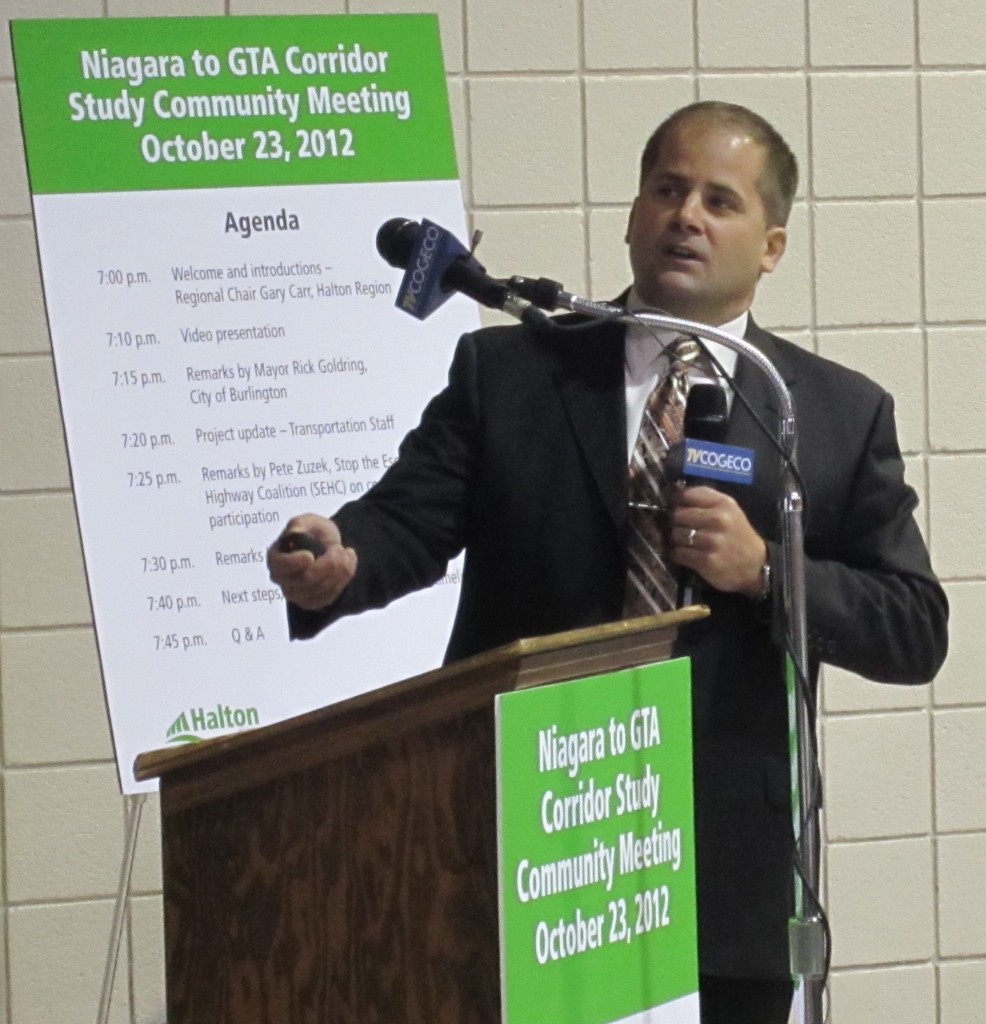
Pete Zuzek argued that SEHC – Stop Escarpment Highway Coalition was the only independent set of eyes watching what the government was doing – and they didn’t like what they were seeing. Zuzek said there was no peer review and that the work being done for a project that would cost as much as $5 billion was both flawed and limited.
Pete Zuzek wants the province to forget about a possible Phase 2 and he explained why – the work being done on the Phase 1 part is flawed and limited. “There is no independent peer review” explained Zuzek ” yet the want to spend $6 billion without a second set of eyes looking at their recommendations.”
What are the next steps? Keeping informed is the biggest part of it. Our Burlington has been on top of this story since the newest assault on the Escarpment by the provincial government became clear back in 2010. We have covered the creation of the SEHC – we were in the room when the deal between the city of Burlington and SEHC was worked out and when they came up with the SEHC name. Back then Burlington said it would support SEHC as advocates who would be able to say and do things the city couldn’t say and do. While the SEHC and city of Burlington relationship gets strained at times – it does work. At one Public Information Centre more than 1200 people turned out to protest. At that session there was an “open mike” segment that heard some very powerful statements. John Taylor, with his impish grin, advised that “they don’t do open mikes anymore.
Whatever the team doing the Environmental Assessment passes on to the government in the way of recommendations, they have to be put those recommendations before the public. And the EA team has to record every objection as part of their final report.
PERL fought the application for a second mine on the Escarpment for more than seven years – and they won. The fight to keep a highway out of the Escarpment will take far more than seven years. Back in the days when Bill Davis was Premier of Ontario he put a stop to an expressway that was planned to run right into the center of Toronto. Governments can make smart decisions – they just have to be nudged in the right direction. Last night at the arena on Mainway, 600 + Burlingtonians gave a bit more than a nudge.
Janet Turpin Myers on her blog put it the way Garry Carr wanted to put it: – “We need to get loud.”















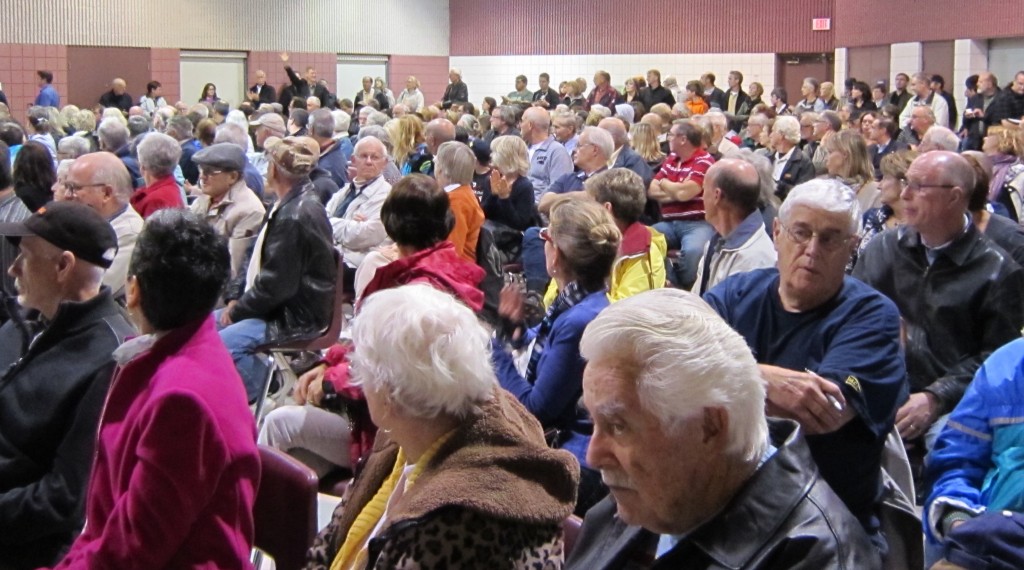




Development in and of itself is not bad, although the new highway certainly will be. Its important not to mix together too many issues here. First, the housing market demands are for single family homes primarily and not the super skyscraper condos envisioned by McGuinty’s smart growth initiatives. Second, the Alton community was a benefit to the city since it was a natural fit for that parcel of land and is immediately adjacent to already developed land. It was easily serviceable, and brought DC’s to the City.
The highway however is another story. I will have a negative impact upon agriculture lands, traffic patterns, smog, etc. It is not a natural fit cutting across the escarpment nor will any development be in the immediate vicinity. If development ddi take place, it would have to be large detached homes on roughly an acre of land since there are currently no services (water/sewer) in the area.
Lastly, I would like to acknowledge that you accurately pointed out that Jane McKenna was again reading from notes. At this stage I would expect her to be able to speak from her own knowledge – especially given this is a local issue and therefore should be top of mind and easy to comprehend. PC Research Services must be working at full capacity to keep her supplied with her daily comments.
First of all I’m sorry I couldn’t attend yesterdays meeting. As it has been stated, once the land is expropriated, the developers will swoop in and start planning new communities. Well guess what. That new highway will become just as congested as all the others our now. Just look what’s happening around the other new ones that have been built. The 407, the 400, the 404 the 410 expansion etc. It’s seems to be an never ending cycle.
When does it stop? after all the best farm land in Ontario is gone. I wonder where the jobs will be when there is nothing left to pave over.